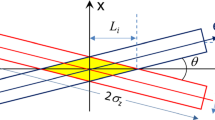Abstract
SuperKEKB is an electron–positron asymmetric-energy double-ring collider, which was built in Japan. It has been operated to explore new phenomena in B-meson decays. Hence, extremely higher luminosity is required. A collision scheme of low emittance with a large Piwinski angle called a “nano-beam scheme” has been adopted to achieve higher luminosity by squeezing the vertical beta function at the interaction point to be smaller than the bunch length. A “crab waist collision scheme” proposed by P. Raimondi et al. has also been adopted to improve the luminosity performance. The article presents an overview of the operation of the nano-beam and crab waist collision schemes at SuperKEKB.







Similar content being viewed by others
Data Availability Statement
This manuscript has associated data in a data repository. [Authors’ comment: All data included in this manuscript are available upon requested by contacting with the corresponding author and the SuperKEKB collaboration at https://www-superkekb.kek.jp.]
References
Y. Ohnishi et al., Prog. Theor. Exp. Phys. 2013, 03A011 (2013)
K. Akai et al., Nucl. Instrum. Methods A907, 188 (2018)
Belle II, Technical Design Report (2010). arXiv:1011.0352
T. Abe et al., Prog. Theor. Exp. Phys. 2013, 03A001 (2013)
M.A. Furman, LBL-30833, ESG-137 (1991)
P. Raimondi, in Presented at the 2nd Workshop on Super B-Factory, Frascati (2006)
SuperB Conceptual Design Report, INFN/AE-07/2, SLAC-R-856,LAL 07-15 March (2007)
K. Watanabe et al., in Proceedings of IPAC’19, Melbourne, Australia, May 19–24 (2019)
Y. Suetsugu et al., in Proceedings of IPAC’16, Busan, Korea, May 8–13 (2016)
Y. Funakoshi et al., in Proceedings of IPAC’16, Busan, Korea, May 8–13 (2016)
N. Ohuchi et al., in Proceedings of IPAC’18, Vancouver, Canada, April 29–May 4 (2018)
D. Zhou et al., in Proceedings of IPAC’10, Kyoto, Japan, May 23–28 (2010)
M. Masuzawa et al., in Proceedings of IPAC’16, Busan, Korea, May 8–13 (2016)
Y. Ohnishi. arXiv:1904.10236 (2019)
M. Zobov et al., Phys. Rev. Lett. 104, 174801 (2010)
M. Hostettler, Ph.D Thesis, CERN-THESIS-2018-051, June 21 (2018)
A. Abada et al., Eur. Phys. J. Special Top. 228, 261–623 (2019)
CEPC Conceptual Design Report. arXiv:1809.00285 September (2018)
Q. Luo et al., in Proceedings of IPAC’19, Melbourne, Australia, May 19–24 (2019)
A. Bondar et al., Phys. Atom. Nucl. 76, 1072–108 (2013)
P. Raimondi et al., LNF-07-003-IR (2007)
D. Shatilov et al., Phys. Rev. ST Accel. Beams 14, 014001 (2011)
K. Oide et al., Pys. Rev. Accel. Beams 19, 111005 (2016)
K. Furukawa et al., in Proceedings of IPAC’18, Vancouver, Canada, April 29–May 4 (2018)
T. Ishibashi et al., Phys. Rev. Accel. Beams 23, 053501 (2020)
H. Sugimoto et al., in Proceedings of IPAC’19, Melbourne, Australia, May 19–24 (2019)
Y. Ohnishi et al., Phys. Rev. ST Accel. Beams 12, 091002 (2009)
R. Sugahara et al., IEEE Trans. Appl. Supercond. 26(2016)
Acknowledgements
We thank the MDI group of the Belle II collaboration for helping with the machine tuning and physics operation. Further, we thank all members of the INFN(LNF)-KEK collaboration for the fruitful discussions on the crab waist collision scheme. This work is supported by KEK and Ministry of Education, Culture, Sports, Science and Technology (MEXT), Japan.
Author information
Authors and Affiliations
Corresponding author
Rights and permissions
About this article
Cite this article
Ohnishi, Y., Abe, T., Akai, K. et al. SuperKEKB operation using crab waist collision scheme. Eur. Phys. J. Plus 136, 1023 (2021). https://doi.org/10.1140/epjp/s13360-021-01979-8
Received:
Accepted:
Published:
DOI: https://doi.org/10.1140/epjp/s13360-021-01979-8




